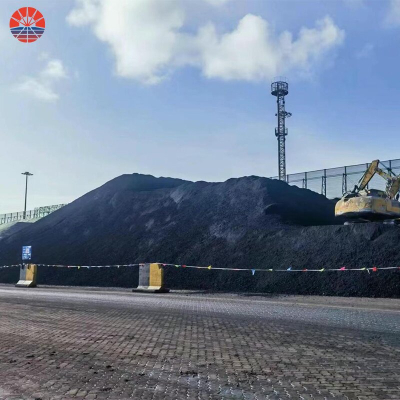The Production Process Of Ferrosilicon
The production process of ferrosilicon primarily involves the smelting of silica (usually in the form of quartz) and iron in a submerged arc furnace. Here's a step-by-step explanation of the ferrosilicon production process:
Raw materials preparation: The main raw materials used in ferrosilicon production are silica (SiO2) and iron (Fe). These materials are typically obtained in the form of quartz (silica) and iron ore, although other iron-containing materials like mill scale or iron scrap can also be used. The raw materials are carefully selected and blended to achieve the desired composition for the ferrosilicon alloy.
Charging the submerged arc furnace: The prepared mixture of silica and iron-containing materials is loaded into a submerged arc furnace. This type of furnace is a large, refractory-lined vessel with three or more graphite electrodes that extend into the furnace from the top.
Heating and reduction: An electric current is passed through the electrodes, creating an electric arc between the electrodes and the raw materials. This arc generates intense heat, raising the temperature inside the furnace to around 2,000 to 2,400 degrees Celsius (3,632 to 4,352 degrees Fahrenheit).
Smelting and reduction reactions: At such high temperatures, the silica and iron oxides in the raw materials are reduced by carbon to produce silicon (Si) and iron (Fe). The primary reduction reactions are as follows:
SiO2 + 2C → Si + 2CO
Fe2O3 + 3C → 2Fe + 3CO
In these reactions, carbon (C) acts as the reducing agent, removing oxygen from silica and iron oxides, resulting in the formation of silicon, iron, and carbon monoxide (CO) gas.
Formation of ferrosilicon alloy: The molten silicon and molten iron combine to form the ferrosilicon alloy. The ratio of silicon to iron is controlled to achieve the desired composition based on the specific grade of ferrosilicon required.
Tapping and casting: Once the desired ferrosilicon alloy composition is achieved, the molten metal is tapped from the furnace through tap holes into ladles. From the ladles, the molten ferrosilicon is either cast into molds to create solid blocks or further processed to obtain specific shapes and sizes, depending on the intended application.
Cooling and solidification: The cast ferrosilicon cools and solidifies in the molds, forming solid blocks or shapes.
Crushing and sizing: After solidification, the ferrosilicon is usually crushed into smaller pieces using crushers and then screened to obtain the desired particle size distribution. Different grades of ferrosilicon may have varying size specifications based on their intended applications.
Packaging and distribution: The final ferrosilicon product is packaged and shipped to various industries for use in steelmaking, foundry processes, and other applications.
It's important to note that the production process can be adapted based on the specific requirements of different grades of ferrosilicon and the available raw materials. Additionally, some modern production facilities may use advanced technologies to enhance efficiency and reduce energy consumption during the manufacturing process.
The Usage Of Ferrosilicon
Ferrosilicon is an alloy composed primarily of iron (Fe) and silicon (Si). It is commonly used in various industries due to its unique properties. Here are some of the main uses of ferrosilicon:
Steel production: Ferrosilicon is a crucial additive in the production of carbon and stainless steels. It is used as a deoxidizer and desulfurizer, helping to remove impurities and improve the quality of the final steel product.
Foundry and casting industry: In foundries, ferrosilicon is used as an inoculant to promote the formation of graphite in cast iron. It also helps control the structure and properties of the castings, ensuring desired characteristics are achieved.
Ductile iron production: Ferrosilicon is a key component in the production of ductile iron, also known as nodular or spheroidal graphite iron. It promotes the formation of nodules in the iron, enhancing its strength and ductility.
Magnesium production: Ferrosilicon is used in the production of magnesium, where it acts as a reducing agent in the magnesium extraction process from magnesium oxide ores.
Welding applications: In some welding processes, ferrosilicon is used as a deoxidizing agent, preventing the formation of porosity and ensuring the strength and integrity of the weld.
Chemical industry: Ferrosilicon is used in the manufacturing of silicon-based chemicals and compounds. It is also employed in the production of silicon, which finds applications in electronics and solar cells.
Nuclear reactors: In some nuclear reactors, ferrosilicon is used as a neutron moderator, helping to control the rate of nuclear fission reactions.
Dense media separation: Ferrosilicon is utilized in dense media separation processes for the separation of minerals based on their density. It is particularly important in mining operations to concentrate valuable ores from the gangue (unwanted material).
Friction materials: Ferrosilicon can be used in the production of friction materials such as brake pads and linings due to its heat-resistant properties.
It's important to note that the specific application and composition of ferrosilicon can vary depending on the industry and requirements. The alloy is available in various grades, each tailored to suit different applications.
Specification
Quality inspection certificate of finished product | |||
Product name | Ferro Silicon | Batch No. | ZC2023-06-13 |
Sampling Site | / | Product specifications | / |
Acceptance date | 2023.06.13 | Report date | 2023.06.14 |
Test items | SH/T 0313-92 | Test results | |
Appearance | This product should be black solid | ||
Si | 75.32 | ||
c | 0.11 | ||
P | 0.03 | ||
s | 0.014 | ||
A1 | 0.77 | ||
Conclusion | Product conforms to specification. | ||








